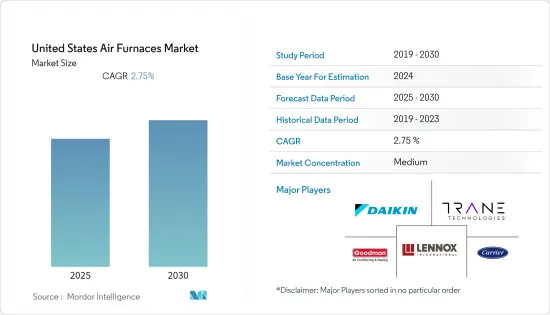
|
시장보고서
상품코드
1635376
미국의 공기로 : 시장 점유율 분석, 산업 동향 및 통계, 성장 예측(2025-2030년)United States Air Furnaces - Market Share Analysis, Industry Trends & Statistics, Growth Forecasts (2025 - 2030) |
||||||
■ 보고서에 따라 최신 정보로 업데이트하여 보내드립니다. 배송일정은 문의해 주시기 바랍니다.
미국의 공기로 시장은 예측 기간 동안 CAGR 2.75%를 기록할 것으로 예상됩니다.

주요 하이라이트
- 부동산 부문에 대한 투자 증가와 산업화 발전이 시장을 주도하는 주요 요인입니다. 미국 전역에서 다양한 상업용 건물과 주택의 건설이 급증하면서 일반 난방기구로서 공기로에 대한 수요가 크게 증가하고 있습니다.
- 미국에서는 에너지 소비의 증가와 더불어 정부 당국의 엄격한 규칙과 규제가 에너지 효율이 높은 난방 장비에 대한 수요를 촉진하고 있습니다. 또한, 에너지 요금의 증가는 많은 산업 및 상업 조직이 작업 현장에 이러한 에너지 효율적인 시스템을 설치하는 요인으로 작용하고 있습니다.
- 또한, 사물인터넷(IoT) 및 인공지능(AI)과 같은 첨단 기술의 채택이 증가하고 있는 것도 시장에 긍정적인 영향을 미치고 있습니다. 공기로에 이러한 기술을 사용하면 에너지를 크게 절약하고 장비의 고장을 방지할 수 있습니다.
- COVID-19 팬데믹의 영향으로 미국의 많은 냉난방 장비 제조업체의 공급망이 혼란에 빠졌습니다. 또한 전염병이 발생함에 따라 많은 주택 건설 프로젝트가 느린 속도로 진행되었고 일부는 취소되어 공기로에 대한 수요도 정체되었습니다.
- 가스 용광로 설치에 소요되는 높은 초기 비용도 시장 억제요인으로 작용하고 있습니다. 또한, 화석연료를 연료로 사용하는 용광로를 완전히 폐지하기 위한 정부 규제가 지연되고 있는 것도 시장 성장을 저해할 것으로 예상됩니다. 예를 들어, 미국 에너지부가 2029년까지 제안한 새로운 규정에 따르면, 미국은 비가열, 저효율, 비응축로의 제조 및 수입을 단계적으로 폐지할 예정입니다.
미국의 공기로 시장 동향
가스로가 큰 시장 점유율을 차지합니다.
- 가스 연소로는 미국에서 가장 보편적인 공기로, 천연가스를 주 연료로 사용합니다. 천연가스는 용광로에서 점화되어 공기를 데우고 덕트를 통해 건물과 가정 곳곳으로 보내집니다.
- 또한, 고온의 연소 가스를 직접 발생시켜 송풍기를 통해 가열실 내부로 보내므로 천연가스로는 빠르게 가열됩니다.
- 천연가스는 미국에서 매우 저렴한 연료입니다. 또한 깨끗하고 효율적입니다. 또한, 가스로는 미국 남부에서 90% 이상, 북부에서 95% 이상의 AFUE(연간 연료이용효율)가 에너지스타 프로그램에 의해 의무화되어 있어 고효율 기기입니다.
- 2021년 1월, 노텍월드HVAC는 간편한 설치/서비스 기능을 갖춘 AFUE 95%의 초저NOx 주거용 용광로인 프리미엄 SD 시리즈를 출시하였습니다. 이 단단식 업플로우/수평형 천연가스 연소로는 회사의 Frigidaire(FG8SD) 및 Maytag(MGC3SD) 브랜드에서 출시되었습니다.
- 천연가스로는 석유로보다 약간 비싸지만, 유지보수가 간단합니다. 그러나 가스로는 일산화탄소 누출의 위험이 있으므로 일산화탄소 감지기를 설치해야 합니다.
크게 성장하고 있는 주택 최종사용자 부문
- 미국 건설 부문의 성장과 독립형 주택 수요의 증가는 주택 부문의 시장 성장을 촉진할 것입니다.
- 미국의 주택 부문은 COVID-19의 영향에서 벗어나 빠르게 회복하고 있습니다. 미국 인구조사국이 발표한 데이터에 따르면 2022년 2월 신규 주택 착공 건수는 전년 동기 대비 22% 증가했습니다. 이는 2006년 이후 가장 빠른 성장률입니다.
- 미국 지역의 기온 차이는 극심한 더위와 추위를 가져와 주거용 공기열에 대한 수요를 자극합니다. 공기로는 수열식 난방 시스템에 비해 가동 시간이 매우 빠르며, 집 전체에 빠르게 쾌적함을 제공할 수 있습니다.
- 공기로를 사용하면 실내 공기의 질도 크게 개선될 수 있습니다. 많은 공기로는 가습 기능을 갖추고 있어 재산 피해와 건강상의 위험을 초래할 수 있는 실내 공기 오염 물질과 습도 문제를 제거할 수 있습니다. 이러한 요인도 시장 성장에 기여하고 있습니다.
- 새로운 에너지 규범이 시행됨에 따라 에너지 효율이 높은 공기로를 사용하는 경향도 증가하고 있습니다. 예를 들어, 미국 에너지부(DOE)는 2022년 6월에 주거용 가스로에 대한 새로운 에너지 효율 기준을 제안하여 온실 가스 배출을 크게 줄이고 소비자가 에너지 요금을 더 많이 절약 할 수 있도록 할 것입니다.
미국의 공기로 산업 개요
미국의 공기로 시장은 중간 정도의 경쟁으로 강력한 플레이어로 구성되어 있습니다. 시장 점유율 측면에서 이러한 중요한 사업자 중 일부는 현재 시장을 장악하고 있습니다. 이 기업들은 시장 점유율을 높이고 수익성을 높이기 위해 전략적 공동 행동을 활용하고 있습니다.
- 2021년 12월 - 다이킨은 워싱턴에 본사를 둔 두 개의 HVAC 유통업체인 Thermal Supply, Inc. 및 AirReps, LLC를 인수하여 북미 시장에서의 입지를 더욱 확대한다고 발표했습니다.
- 2021년 8월 - 레녹스 인터내셔널 산하 Allied Air Enterprises는 엔트리급 단단식 제품에서 2단 가변속 가변속 가스로로의 전환을 제공하는 80% 2단 정토크(CT) 가스로인 Ducane, Concord, Allied 80G2E를 통해 가스로 공급을 확대했습니다.
기타 특전:
- 엑셀 형식의 시장 예측(ME) 시트
- 3개월간의 애널리스트 지원
목차
제1장 소개
- 조사 가정과 시장 정의
- 조사 범위
제2장 조사 방법
제3장 주요 요약
제4장 시장 인사이트
- 시장 개요
- 업계의 매력 Porters 5 Force 분석
- 공급 기업의 교섭력
- 소비자의 협상력
- 신규 참여업체의 위협
- 경쟁 기업 간의 경쟁 관계
- 대체품의 위협
- 업계 밸류체인 분석
- COVID-19 발생 업계에 대한 영향
제5장 시장 역학
- 시장 성장 촉진요인
- 부동산 부문에 대한 투자 증가
- 난방 기구 에너지 효율에 관한 엄격한 규제
- 시장 과제
- 높은 설치 비용
제6장 시장 세분화
- 유형별
- 가스
- 석유
- 전기
- 기타
- 최종사용자별
- 주택
- 상업
- 산업
제7장 경쟁 구도
- 기업 개요
- Carrier Global Corporation
- Lennox International Inc.
- Daikin Industries, Ltd.
- Trane Technologies plc
- Goodman Manufacturing
- Fujistu General Limited
- Boyertown Furnace Co
- Rheem Manufacturing Company
- Nortek Global HVAC
- American Standard Heating & Air Conditioning
제8장 투자 분석
제9장 시장 전망
ksm 25.02.07The United States Air Furnaces Market is expected to register a CAGR of 2.75% during the forecast period.

Key Highlights
- The increasing investments in the real-estate sector and growth in industrialization are the primary factors driving the market. The rapid increase in the construction of different commercial and residential buildings across the United States is creating significant demand for air furnaces as a common type of heating equipment.
- Rising energy consumption along with stringent rules and regulations imposed by governing bodies is driving the demand for energy-efficient heating equipment in the United States. Additionally, increasing energy bills are also influencing many industrial and commercial organizations to install these energy-efficient systems on their working sites.
- Moreover, the increasing adoption of advanced technologies like Internet of Things (IoT) and Artificial Intelligence (AI) is also having a positive impact on the market. The usage of these technologies in air furnaces can result in major energy savings and also prevent equipment failures.
- The impacts of the COVID-19 pandemic disrupted the supply chain for many heating and cooling equipment manufacturers in the United States. Further, with the outbreak of the pandemic, many housing construction projects started to be carried on at a slower pace, while some were cancelled, which also resulted in a stagnant demand for air furnaces.
- The high upfront cost related to the installation of gas furnaces can act as a market restraint. Additionally, slow government regulations to completly phase out fossil fuel powered furnaces in the country is also expected to hinder the growth of the market. For instance, accordin to the new proposed rue from the Enegry department under the the Biden Administration by 2029, the country will phase out manufacturing and imports of non-weatherized, less efficent, non condensing furncese.
US Air Furnaces Market Trends
Gas Furnaces to Hold a Major Market Share
- Gas-fired furnaces are the most common type of air furnaces in the US and utilize natural gas as their primary source of fuel. The natural gas is ignited in the furnace, warming up the air, which is then distributed through ducts to various parts of a building or the home.
- Further, owing to the direct generation of high-temperature combustion gas, which is directed through a heating chamber by using an air blower, a natural gas furnace heats up quickly.
- Natural gas is a very affordable fuel source in the United States. It is also clean and efficient. Moreover, gas furnaces are required to have a minimum AFUE (Annual Fuel Utilization Efficiency) rating of 90% in Southern US and 95% in Northern US, as per Energy Star, making them high-efficiency appliances.
- In January 2021, Nortek Global HVAC launched the premium SD Series, a 95% AFUE, ultra-low NOx residential furnace that offers easy installation/service features. The single-stage, upflow/horizontal, natural gas-fired furnaces are available from the company's Frigidaire (FG8SD) and Maytag (MGC3SD) brands.
- While natural gas furnaces can be slightly more expensive than oil furnaces, they are easier to maintain. However, gas furnaces carry the danger of carbon monoxide leaks, making it necessary to install carbon monoxide detectors.
Residential End-User Sector to Grow Significantly
- The growth in the US construction sector coupled with the rise in the demand for independent houses fuels the market growth in the residential sector, as air furnaces are extensively used in residential buildings to regulate the temperature in winter and summer by providing consistent air circulations.
- The US housing sector is picking up at a fast rate, recovering from the effects of the pandemic. As per the data released by the US Census Bureau, new home construction starts in February 2022 increased by 22% compared with the same period in the previous year. This is the fastest growth rate in building since 2006.
- Temperature variations in U.S. regions result in extreme hot or cold weather, which stimulates the demand for residential air furnaces. Air furnaces have much faster start times, as compared to hydronic heating systems, and can quickly provide comfort to the entire home.
- The use of air furnaces can also improve indoor air quality significantly. Many furnaces are equipped with humidification, which allows for the removal of a lot of indoor air contaminants and humidity problems that can cause property damage and health problems. These factors also contribute to the market growth.
- The trend of using energy-efficient air furnaces is also growing with the implementation of new energy norms. For instance, in June 2022, the US Department of Energy (DOE) proposed new energy-efficiency standards for residential gas furnaces that would significantly reduce greenhouse gas emissions and provide more savings for consumers on their energy bills.
US Air Furnaces Industry Overview
The United States Air Furnaces Market is moderately competitive and consists of some influential players. In terms of market share, some of these important actors currently manage the market. These businesses are leveraging strategic collaborative actions to improve their market percentage and enhance their profitability.
- December 2021 - Daikin announced the acquisition of two Washington-based HVAC distributors, Thermal Supply, Inc. and AirReps, LLC., further expanding its presence in North America.
- August 2021 - Allied Air Enterprises, a Lennox International company, expanded its gas furnace offering with the Ducane, Concord and Allied 80G2E, an 80% two-stage constant torque (CT) gas furnace that provides a progression from entry-level single-stage product to two-stage variable speed furnaces.
Additional Benefits:
- The market estimate (ME) sheet in Excel format
- 3 months of analyst support
TABLE OF CONTENTS
1 INTRODUCTION
- 1.1 Study Assumptions and Market Definition
- 1.2 Scope of the Study
2 RESEARCH METHODOLOGY
3 EXECUTIVE SUMMARY
4 MARKET INSIGHTS
- 4.1 Market Overview
- 4.2 Industry Attractiveness-Porters 5 Force Analysis
- 4.2.1 Bargaining Power of Suppliers
- 4.2.2 Bargaining Power of Consumers
- 4.2.3 Threat of New Entrants
- 4.2.4 Intensity of Competitive Rivalry
- 4.2.5 Threat of Substitutes
- 4.3 Industry Value Chain Analysis
- 4.4 Impact of COVID-19 Outbreak on the Industry
5 MARKET DYNAMICS
- 5.1 Market Drivers
- 5.1.1 Increasing Investments in the Real-Estate Sector
- 5.1.2 Strignent Regulations Regarding Energy Efficiecy of Heating Devices
- 5.2 Market Challenges
- 5.2.1 High Cost of Installation
6 MARKET SEGMENTATION
- 6.1 By Type
- 6.1.1 Gas
- 6.1.2 Oil
- 6.1.3 Electric
- 6.1.4 Others
- 6.2 By End-User
- 6.2.1 Residential
- 6.2.2 Commercial
- 6.2.3 Industrial
7 COMPETITIVE LANDSCAPE
- 7.1 Company Profiles
- 7.1.1 Carrier Global Corporation
- 7.1.2 Lennox International Inc.
- 7.1.3 Daikin Industries, Ltd.
- 7.1.4 Trane Technologies plc
- 7.1.5 Goodman Manufacturing
- 7.1.6 Fujistu General Limited
- 7.1.7 Boyertown Furnace Co
- 7.1.8 Rheem Manufacturing Company
- 7.1.9 Nortek Global HVAC
- 7.1.10 American Standard Heating & Air Conditioning
8 INVESTMENT ANALYSIS
9 FUTURE OF THE MARKET
샘플 요청 목록



















